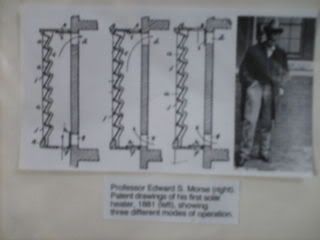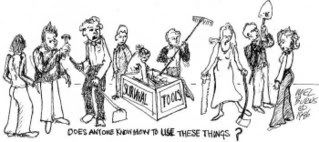From void into vision, from vision to mind, from mind into speech, from speech to the tribe, from the tribe into din.
Showing posts with label video. Show all posts
Showing posts with label video. Show all posts
Monday, March 09, 2009
Solar Fountain at the Farmers' Market
I take my solar fountain out for a walk from time to time at farmers' markets and in the city squares. Around the fountain are posters which display what I think are some of the rules of living within a restorative ecology. The splash of water makes a difference in public and children like to learn that they can turn the fountain on and off with the shadow of a hand.
Solar Fountain at the Farmers Market
More energy demo ideas for farmers' markets at Mr Franklin's Folks.
Monday, November 17, 2008
Windowbox Solar Air Heater
This is a demonstration model of a solar windowbox air heater.
You can build it from a sheet of insulation board, some clear glass or plastic, and a furnace air filter painted black.
When the sun shines, the black absorber inside the insulated windowbox gets hot, heating air which rises into the room behind the window, and drawing cooler air from inside that room past the absorber in a thermal loop that lasts until the sun goes down.
At night, the cold air sinks to the bottom of the windowbox and closes off this thermal loop so there is no additional night time heat loss.
Increase the efficiency of the windowbox solar air heater with a solar electric, photovoltaic, PV fan.
This demonstration model uses a repurposed solar car window ventilator. Only when the sun hits the PV panel does the fan move air, an automatic solar circuit thermostatic control.
The windowbox solar air heater is a supplemental heater for one room with a south-facing window and can be modified to provide increased ventilation and cooling in the summer as Edward Sylvester Morse's 1881 solar air heater design did.

Cost for a 2 foot by 3 foot insulation board solar windowbox air heater is around $100. PV fan car vents are available for as little as $5. One recently built windowbox has heated air by at least 20º Fahrenheit, from 65 to 85º, and will do so all winter.
Labels:
do it yourself,
ecology,
energy,
environment,
solar,
video
Monday, August 27, 2007
M. Preston Burns, Pandora's Box, Experiential Geometry
I've been experimenting for over thirty years with geometric models. Recently, my collaborator and the man who introduced me to this work, M Preston Burns, died and I have been going over his portfolio and papers. Mel or, as I knew him, Bud Burns worked primarily with the cube and the tetrahedron. He divided the square faces of the cube on the diagonal revealing the equilateral tetrahedron packed inside. He cut and hinged the cube and made a winged tetrahedron, eight hinged equilateral triangles, to fit inside. Then he filled the corners with ToyBlox, wooden forms which demonstrated the two-fold symmetries of the cube and tetrahedron. He called it Pandora's Box and demonstrated six inch, one foot, four, six, and eight foot models publicly since around 1970 when he built the first prototype.
This is a short video of what was probably his last presentation of Pandora's Box :
The advantage of working with these models is that they teach geometry and symmetry experientially, without the need of numbers or words. These forms are inherent in dimensionality. They are true, in the way a carpenter measures true - straight, level, plumb. By having three dimensional models you can turn around in your hands, you develop a hand-eye relationship with fundamental geometric forms. The cube and tetrahedron models of Pandora's Box teach the relationship between the right triangle and the equilateral triangle as well as two-fold and three-fold symmetry viscerally. This is full contact mathematics.
If you are interested in this kind of experiential geometry, there will be a symposium on "Synergetics and Morphology" at the Rhode Island School of Design on November 3 and 4, 2007 in Providence, RI. Further information is available from the Synergetics Collaborative
Another short video of Bud outlining his symbology system:
His friends will remember M Preston Burns at the current exhibit of his work in Cambridge, MA at Toscanini's Ice Cream, 899 Main Street on Tuesday, August 28 at 7 pm.

You can see more of his drawings at Bud's Gallery
This is a short video of what was probably his last presentation of Pandora's Box :
The advantage of working with these models is that they teach geometry and symmetry experientially, without the need of numbers or words. These forms are inherent in dimensionality. They are true, in the way a carpenter measures true - straight, level, plumb. By having three dimensional models you can turn around in your hands, you develop a hand-eye relationship with fundamental geometric forms. The cube and tetrahedron models of Pandora's Box teach the relationship between the right triangle and the equilateral triangle as well as two-fold and three-fold symmetry viscerally. This is full contact mathematics.
If you are interested in this kind of experiential geometry, there will be a symposium on "Synergetics and Morphology" at the Rhode Island School of Design on November 3 and 4, 2007 in Providence, RI. Further information is available from the Synergetics Collaborative
Another short video of Bud outlining his symbology system:
His friends will remember M Preston Burns at the current exhibit of his work in Cambridge, MA at Toscanini's Ice Cream, 899 Main Street on Tuesday, August 28 at 7 pm.

You can see more of his drawings at Bud's Gallery
Monday, August 06, 2007
Dancing the Cube in Jamaica
This is a video Julie of Videosphere took December 2006 of Azisu, Nikita, Chaka, Werner, and Bud playing with a magnetic Quanta Cube, a cube made of 72 A and B Quanta. The A and B Quanta are the smallest common symmetrical tetrahedra of the regular tetrahedron and octahedron, two of the Platonic Solids. They were first discovered and analyzed by R Buckminster Fuller and Dr Arthur Loeb. Both the A and B Quanta come in left-hand and right-hand pairs, they are mirror images of each other, enantiomorphs. As positive/negative pairs, they are perfect for magnetic coupling and there are magnets at the centers of each of the four faces of each Quanta in the Quanta Cube, 288 magnets in all.
The Quanta Cube is derived from the work of M. Preston Burns, Bud, the skinny old dude in the video, who built his first Pandora's Box nearly 40 years ago. We worked together building various models of the box at different scales from eight feet to six inches and demonstrated them before the public and as part of an arts curriculum with Tribal Rhythms. Bud dissected a cube along its diagonals, hinged the pieces, and packed a "winged tetrahedron," a hinged tetrahedron with eight equilateral triangles, in the center. He filled the corners of the cube with ToxBlox, illustrating the symmetrical divisions of the cube. That is Pandora's Box.
One day, I was playing with a set of A and B Quanta I had made and discovered how to fill the box with A and B Quanta. Later I developed the magnetic coupling system with Carl Fasano of RISD.
More on Synergetic geometry and R. Buckminster Fuller at
http://www.rwgrayprojects.com/synergetics/synergetics.html
http://synergeticists.org
http://www.bfi.org/
More video of the Quanta Cube at
http://energyvision.blogspot.com/2006/02/evolution-of-cube.html
More geometry video from RISD:
http://energyvision.blogspot.com/2006/02/geometry-study.html
Monday, February 26, 2007
Solar in Thirty Second Segments
I made these thirty second public service announcements for public access TV around 1991. They served as intro and outro to the videos of the Boston Area Solar Energy Association lectures I shot and cablecast on Cambridge Community TV for a few years. The tape archive of all those lectures needs to be digitized.
The modern history of solar is hidden in plain sight but the best book I know on the earlier 2500 years is still A Golden Thread by John Perlin and Ken Butti.
I still don't understand the relationship between a calorie and a watt. I understand the btu though. Sorry, physicists.
These two trick questions were collaborations with the polymathic Ed Hill.
The modern history of solar is hidden in plain sight but the best book I know on the earlier 2500 years is still A Golden Thread by John Perlin and Ken Butti.
I still don't understand the relationship between a calorie and a watt. I understand the btu though. Sorry, physicists.
These two trick questions were collaborations with the polymathic Ed Hill.
Subscribe to:
Comments (Atom)